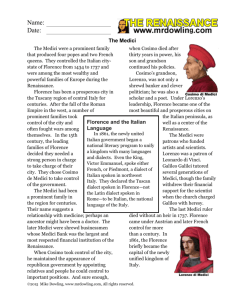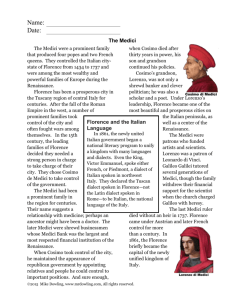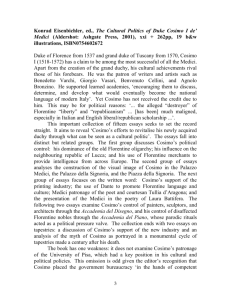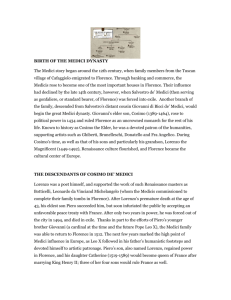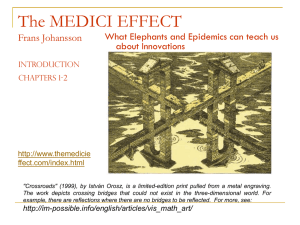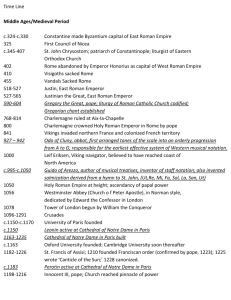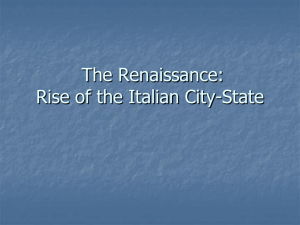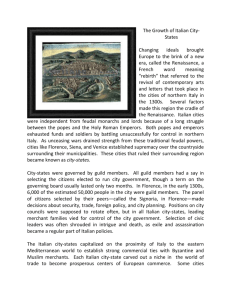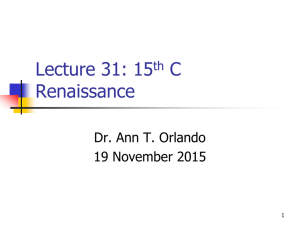Carsen Winn FYSE Paper Cosimo the Elder History has seen its fair
advertisement
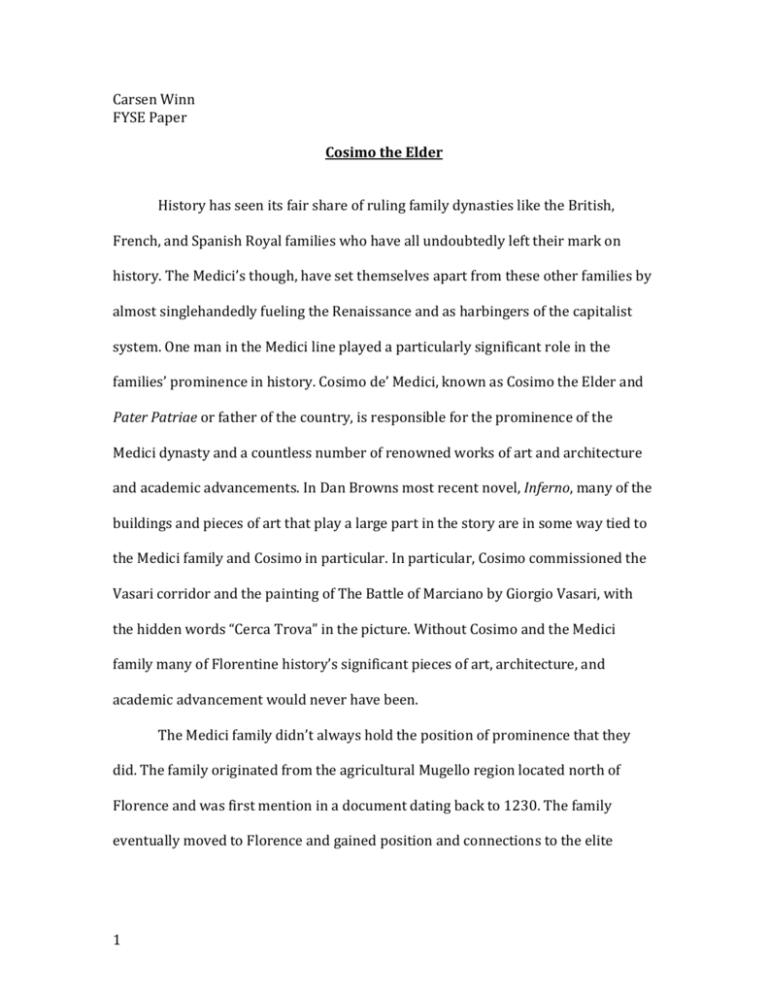
Carsen Winn FYSE Paper Cosimo the Elder History has seen its fair share of ruling family dynasties like the British, French, and Spanish Royal families who have all undoubtedly left their mark on history. The Medici’s though, have set themselves apart from these other families by almost singlehandedly fueling the Renaissance and as harbingers of the capitalist system. One man in the Medici line played a particularly significant role in the families’ prominence in history. Cosimo de’ Medici, known as Cosimo the Elder and Pater Patriae or father of the country, is responsible for the prominence of the Medici dynasty and a countless number of renowned works of art and architecture and academic advancements. In Dan Browns most recent novel, Inferno, many of the buildings and pieces of art that play a large part in the story are in some way tied to the Medici family and Cosimo in particular. In particular, Cosimo commissioned the Vasari corridor and the painting of The Battle of Marciano by Giorgio Vasari, with the hidden words “Cerca Trova” in the picture. Without Cosimo and the Medici family many of Florentine history’s significant pieces of art, architecture, and academic advancement would never have been. The Medici family didn’t always hold the position of prominence that they did. The family originated from the agricultural Mugello region located north of Florence and was first mention in a document dating back to 1230. The family eventually moved to Florence and gained position and connections to the elite 1 through a series of arranged marriages.1 The family was able to elevate its position through banking and commerce and by 1397 Giovanni de Medici founded the Medici Bank and established its headquarters in Florence. The bank rose to eventually become the official bank of the Papal Court. Through Giovanni’s wealth and influence he was able to hold a number of political offices that only increased the influence of the Medici family. Upon his death in 1429, Giovanni left an immense fortune to his son Cosimo. With this inheritance Cosimo was able to consolidate political power for himself while also maintaining the appearance of a democratic government. It was made clear however, that Cosimo alone ruled the city. Cosimo was an avid and faithful supporter of the arts. He commissioned many artists to create pieces for his family’s private collections and many historical architectural monuments. Cosimo enabled the Medici family to become patrons to several legendary artists and philosophers. Leonardo da Vinci, Michelangelo, and Galileo Galilei are only a few supported by the family. Cosimo was also a major supporter of education, sponsoring the Platonic Academy for the study of the ancient works located in Florence.2 The academy was dedicated to the study of philosophy and the classics and was almost entirely supported by Cosimo. It is estimated that by his death in 1464, Cosimo had spent over 600,000 gold florins, the equivalent of $120,000,000 US, towards the advancement of art, architecture, and scholarly 1 Padgett, John F.; Ansell, Christopher K. (May 1993). "Robust Action and the Rise of the Medici, 1400–1434". The American Journal of Sociology 2 Cosimo de' Medici and the 'Platonic Academy' James Hankins Journal of the Warburg and Courtauld Institutes Vol. 53, (1990) (pp. 144-162) 2 learning.3 Cosimo’s son Piero ruled for five years and was then succeeded by Cosimo’s grandson Lorenzo de Medici. Lorenzo, known as Il Magnifico, lived much more lavishly than his predecessors and enjoyed the perks of power more than his father and grandfather had. Under Lorenzo the Florentine economy grew significantly and the lower classes experienced greater levels of comfort and protection. During this time Florence had become the central city-state in Italy and also the most beautiful. Arts and commerce flourished, but the Medici family business declined from Lorenzo’s neglect. Two years after Lorenzo’s death the Medici’s were forced to flee Florence. An uprising birthed by a fanatical priest, Girolamo Savonarola, who preached against the “lavishness, worldliness, and paganism” of the Renaissance called for a return to the old ways of simple faith.4 The family was ousted in 1494 and Savonarola assumed power. He burned many works of the Renaissance that he viewed as immoral and implemented many other unfavorable policies. Eventually, under assault by a mob, Savonarola was burned at the stake as a heretic.5 The Medici were able to return to the city but were never able to restore its former prominence. Cosimo was a devoted supporter of the arts and many of the pieces created on his behalf served to further the family’s position. Cosimo was able to fund the countless number of paintings he commissioned through the wealth of the Medici bank. Cosimo usually chose the artist and subject and he used the art to showcase 3 Italian Renaissance (1330-1550).” SparkNotes LLC. n.d.. http://www.sparknotes.com/history/european/renaissance1/ (accessed October 1, 2013).) 4 SparkNotes Editors. “SparkNote on Italian Renaissance (1330-1550).” SparkNotes LLC. n.d.. http://www.sparknotes.com/history/european/renaissance1/ (accessed October 1, 2013).) 5 Weinstein, Savonarola The Rise and Fall of a Renaissance Prophet 3 the wealth, power, and status that the Medici family possessed. These paintings became material manifestations of the Medici’s power and acted as propaganda and a reminder of the family’s authority. One painting in particular, the Adoration of the Magi by Sandro Botticelli, goes one step further. The painting depicts Biblical characters kneeling before the Virgin Mary and Jesus and presenting gifts. It also features several members of the Medici family including Cosimo himself and his sons Piero, Giovanni, Giuliano, and Lorenzo. Giorgio Vasari describes the scene as “the finest of all that are now extant for its life and vigor”.6 “The importance of the imagery is most famously registered in the decoration of the Medici palace chapel where portraits of the family ad their allies are placed in the retinue of the philosopher kings”.7 The painting put the Medici on level equal to that of biblical figures and sent a message to the people of Florence concerning the greatness of the Medici. The Adoration of the Magi wasn’t the only painting 6 "Adoration of the Magi". Mountain West Digital Library. Utah Academic Library Consortium 7 Sara Sturm, Lorenzo de’ Medici (New York: Twayne Publishers, 1974) 4 commissioned by Cosimo that featured the Virgin Mary as its centerpiece. The San Marco Altarpiece, also known as Madonna and Saints, by Fra Angelico depicts the Virgin and Child surrounded by Angels and Saints. The painting was commission by Cosimo to be the Altarpiece of the San Marco Church in Florence after the Church petitioned Cosimo to fund and oversee badly needed renovations. The Church had changed hands many times since its consecration in the 12th century. Originally the site was home to a Vallombrosan monastery and later passed to Benedictine monks of the Silvestrine line. In 1435 the Church again changed hands to Dominicans from the Convent of San Domenico. Two years after their acquisition, the Dominicans petitioned Cosimo to fund a renovation of the entire complex. Most of the work was delegated to Michelozzo di Bartolomeo Michelozzi but Fra Angelico, a Dominican himself, was given the task of creating the altarpiece. The piece is famous for its use of metaphors of perspective. The painting has curtains that create the effect of looking through a window and into the scene. “The window metaphor implies a continuity between real space and the space of the image”.8 Another painting that Cosimo de Medici commissioned was The Battle of Marciano by Giorgio Vasari. 8 Fra Angelico’s San Marco Altarpiece and the Metaphors of Perspective Barnaby Nygren Source: Notes in the History of Art, Vol. 22, No.1 (Fall 2002), pg. 25-32 Published by: Ars Brevis Foundation, Inc. 5 This painting is especially important to Dan Browns Inferno, as it is the painting that hides the words “Cerca Trova”. The painting was commissioned to commemorate the Battle of Marciano, also known as the Battle of Scannagallo, where the Duchy of Florence defeated the Republic of Siena in the countryside of Marciano della Chiana near Arezzo, Tuscany. In 1554 Cosimo de’ Medici commenced a campaign to conquer the republic of Siena, Florence’s only remaining rival in Tuscany. Florence was supported by Spain and the Holy Roman Empire while France supported Siena. The battle resulted in a decisive Florentine victory with Siena having lost 4,000 men in battle and another 4,000 captured while the Florentine forces lost only 200 men. The victory no doubt helped Cosimo solidify his position of power in the eyes of Florence’s citizens, and by commemorating the victory as a painting Cosimo spread the news of his success and created a reminder for the people of his power. Cosimo’s patronage of the arts extended beyond paintings, as he commissioned a number of the world’s most famous sculptures. After Michelozzo built the Medici their personal residence the Palazzo Medici, Cosimo hired Donato di Niccolò di Betto Bardi, commonly known as Donatello, to create two sculptures to be 6 used as the centerpieces of the Palazzo’s courtyard. The two pieces Donatello created were the bronze David and Judith and Holofernes. The bronze David, not to be confused with the massive marble David by Michelangelo, is famous for being the first unsupported standing bronze cast during the Renaissance and the first freestanding nude male sculpture made since antiquity. The sculpture depicts a triumphant David standing over the severed head of the giant Goliath. Having David be the centerpiece of their personal residences courtyard was a daring move for the Medici, as it made a statement that they owned David. David was a symbol of Florence and by saying they owned David, they subtly implied that they owned Florence as well. Because of the potential backlash from such a bold move, Donatello made a few discreet adjustments to the image of David to make it less recognizable. He added a feather to Goliath’s helmet that appeared to be attached to David’s foot. The hope was that some would think the piece was of the Greek messenger god Hermes. Donatello also added slight breasts to David so that from a side profile when his leg was blocking his genitals, he could be construed 7 as a woman. Though the piece is certainty a highlight of Cosimo’s patronage in the arts, it isn’t without its controversy. In the 16th century the Herald the Signoria said that, “The David in the courtyard is not a perfect figure because its right leg is tasteless”.9 This is because the definition of David’s legs is lacking though among 20th and 21st century art historians this has been justified by the fact that David is supposed to be a young boy and cant be expected to have the muscle definition of an adult. Possibly Florence’s most renowned piece of architecture owes its existence to Cosimo. The Basilica di Santa Maria del Fiore is only one of the structures that were created from Cosimo’s patronage. Built by Filippo Brunelleschi the Basilica di Santa Maria, commonly known as the Duomo, was the first octagonal dome in history to be built without a wooden supporting frame. Construction of the Basilica began in 1296 with sculptor and architect Arnolfo di Cambio at the helm. Arnolfo died in 1302 and work on the cathedral stalled. For the next hundred years the cathedral remained unfinished. However in 1418 the Arte 9 Gaye, G. (1840) Carteggio inedito d'artisti dei secoli xiv.xv.xvi., 3 vols., Florence, II: 456: "El Davit della corte è una figura et non è perfecta, perchè la gamba sua di drieto è schiocha." Cited in Shearman, John (1992) Only Connect...Art and the Spectator in the Italian Renaissance, Princeton: Princeton University Press, 22 n. 17 8 della Lana held a structural design competition where the winner would be appointed the task of erecting the dome of the Basilica. Brunelleschi supported by Cosimo won the position with his ingenious design of the dome. The Duomo, today one of Florence’s biggest tourists attractions, is considered to be Cosimo’s paramount achievement as a patron. The massive dome can be seen throughout the city and the shadow that it casts over the city is comparable to the influence of the Medici in Florence. These are only a few of the immeasurably important pieces of art and architecture that Cosimo was responsible for. His patronage of artists allowed for the creation of some of histories most famous pieces. Without Cosimo’s passion there may never have been a David and a Duomo or a Da Vinci and Michelangelo. No other family has done more for the advancement of art than the Medici’s. They paved the way for the Renaissance and the cultural revolution that it brought. The Renaissance was the bridge that allowed man to cross from the Middle Ages into the modern era and it was made possible in large part by Cosimo and the artists he supported. 9 Bibliography 1. Padgett, John F.; Ansell, Christopher K. (May 1993). "Robust Action and the Rise of the Medici, 1400–1434". The American Journal of Sociology 2. Cosimo de' Medici and the 'Platonic Academy' James Hankins Journal of the Warburg and Courtauld Institutes Vol. 53, (1990) (pp. 144-162) 3. Italian Renaissance (1330-1550).” SparkNotes LLC. n.d.. http://www.sparknotes.com/history/european/renaissance1/ (accessed October 1, 2013).) 4. SparkNotes Editors. “SparkNote on Italian Renaissance (1330-1550).” SparkNotes LLC. n.d.. http://www.sparknotes.com/history/european/renaissance1/ (accessed October 1, 2013).) 5. Weinstein, Savonarola The Rise and Fall of a Renaissance Prophet. http://www.scribd.com/doc/151463168/Savonarola-the-Rise-and-Fall-of-aRenaissance-Prophet 6. "Adoration of the Magi". Mountain West Digital Library. Utah Academic Library Consortium 7. Sara Sturm, Lorenzo de’ Medici (New York: Twayne Publishers, 1974) 8. Fra Angelico’s San Marco Altarpiece and the Metaphors of Perspective, Barnaby Nygren, Source: Notes in the History of Art, Vol. 22, No.1 (Fall 2002), pg. 25-32, Published by: Ars Brevis Foundation, Inc. 9. Gaye, G. (1840) Carteggio inedito d'artisti dei secoli xiv.xv.xvi., 3 vols., Florence, II: 456: "El Davit della corte è una figura et non è perfecta, perchè la gamba sua di drieto è schiocha." Cited in Shearman, John (1992) Only Connect...Art and the Spectator in the Italian Renaissance, Princeton: Princeton University Press, 22 n. 17 10 11
